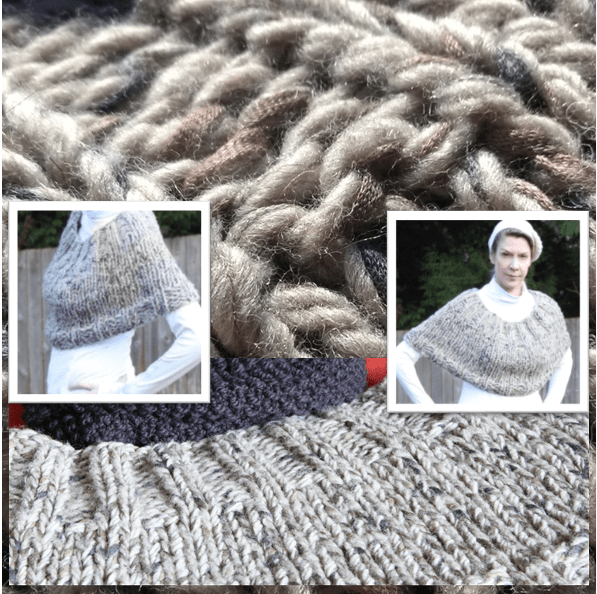
How this pattern came together was trial and error. And while the pattern creation took several days, the actual knitting was 3 hours—total. A nice afternoon project with great results. Also of benefit is that I not only have a warm wear around the shoulders garment, I used up two yarns had had which were too much for a scarf/hat and not enough for a sweater.
I spent one whole day knitting swatches and seeing how the two yarns worked together. The main color is a single hand spun natural hank of worsted wool I picked up in Holbrook Arizona, just south of the Navaho Indian reservation. The other was three balls of wool ribbon yarn from my grandmother’s stash.
My inspiration for this garment was after I saw an Eileen Fisher capelet on a fashionista at work. I asked to inspect it more closely and it is from this that I chose the method of reducing—the creation of a seam in the back. Eileen’s was with a bulky fuzzy black yarn in garter stitch (so every other row knit/purl in the round) and had no border. I wanted both more and less texture. Less fuzz to show the yarns. Ribbing create visual appeal.
Supplies:

Pattern shown in photograph is made with three yarns held together:
- Two hanks (~250-320 yards each) of worsted weight wool
- Three skeins of ribbon yarn (I used a wool ribbon of unknown origin) of approximately DK weight
Substitute the same length of single strand of super bulky or two strands of bulky held together or whatever gives you the appropriate gauge.
Gauge:
5 stitches and 10 rows in a 4” x 4” square using whatever needle gives you this gauge (I used US -15).
Pattern:
Cast on 72 stitches and place stitch marker. Then continued in the round being careful not to twist.
Rows 1-4: K2P2 ribbing.
Row 5: Knit to marker
Rows 6-14: At marker K2tog, knit to end of row
63 Stitches remain
Rows 14-16: Knit even (do not reduce)
Rows 17: At marker K2tog and switch to K2 P2 ribbing
62 Stitches remain
Rows 18-30: Knit evening (do not reduce) in K2 P2 ribbing
Bind off in K2 P2 ribbing pattern
What I would do differently…
- I would hide the reductions by doing something farther out from the marker and evenly on each side. While there is a “cool” triangle on the back of the garment, I think a more subtle look would be better.
- I would even up the top and bottom rib for symmetry. I wanted more ribbing at the top to keep it up higher on my shoulders, but I think it would look better if I’d made them the same size.
What I would do the same…
- The yarns speak for themselves. I’d do less ribbing to show off the variegation in the wool ribbon yarn against the natural variations in the hand spun wool.
- Keep it this simple. What really makes the capelet visually elegant is the simplicity.


This is beautiful. What size needles did you use?
LikeLike
Size 15 US. I’ll update the pattern!
LikeLike
What size needle to knit in round? It is not posted unless I missed it
Also you mentioned two hanks. What is hanks?
Thank you
Carole
In Ohio USA
LikeLiked by 1 person
Use the needle size is whatever one, in a swatch, results in the pattern gauge. Everyone is different, so it is intentional that there is no needle specified–though I added a comment about which I used. But my needle is unlikely to be your needle size. It will be depend on how many strands of yarn you hold together and how tightly (or loosely) you knit.
Hanks are typically 100g in weight–about double the typical skein (though some skeins are also 100g).
I hope this helps!
LikeLiked by 1 person